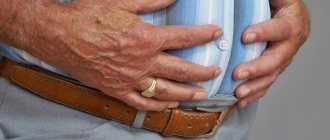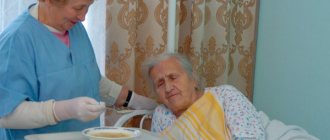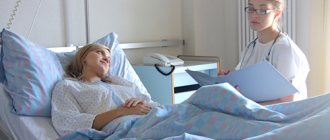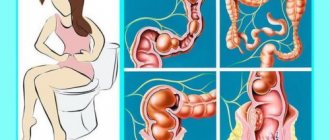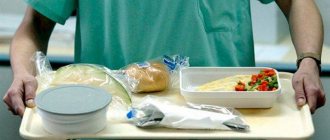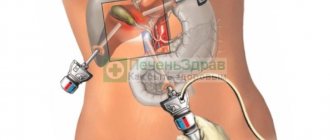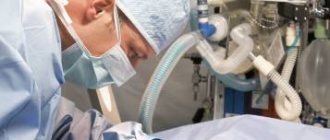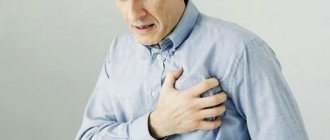The first day after the intervention
The rehabilitation period after appendectomy is 2 months. Young patients who led a healthy and active lifestyle before the intervention recover faster. It is more difficult for children and overweight people to recover.
It is important to understand that removal of the appendix is a wide-ranging open intervention and the doctor’s recommendations on behavior in the postoperative period should be taken with full attention!
After the operating room, the patient goes to the surgical ward, and not to the intensive care unit. Intensive care unit after appendectomy is not indicated.
The intervention is carried out under general anesthesia, so in the first hours after the operation it is important to properly remove the patient from this state, prevent disturbances in brain function and prevent vomit from entering the trachea and lungs. What should you do on the first day:
- Lie for the first 8 hours after the intervention and only on your left side. This promotes free passage of vomit and less additional trauma to the patient.
- If the patient's condition is satisfactory, then after 8 hours he is allowed and even prescribed to sit down, make careful movements, stand with the help of a nurse or on his own.
- During this period, the administration of injectable painkillers and antibiotics is prescribed to stop a possible inflammatory process.
The duration of stay in the surgical department is no more than 10 days. If the patient is confidently recovering, then, as a rule, he is transferred to outpatient treatment on the 4th day after the intervention. What medical staff must do:
- monitoring of temperature, blood pressure, condition of sutures;
- monitor the quality and quantity of urination and bowel movements;
- dressings;
- prevention of possible complications.
When can you drink alcohol after appendectomy?
For a month after the appendectomy, professional sports are out of the question. To keep athletes in shape, physical therapy is mandatory. Its main emphasis is on the work of the muscles of the limbs. The abdominal muscles should be at rest during this period. After a month, you can include them in a set of exercises, but not very intense ones.
It is also better to refrain from running during this time. It is replaced by leisurely walking and leg exercises. Full weightlifting is permissible no earlier than after 3 months. Fans of active sports games (football, volleyball, basketball, etc.) should follow the same rule.
Abuse of alcoholic beverages is strictly contraindicated in any case and does not depend on the duration of the postoperative period. Low alcohol drinks and strong alcohol can be consumed in moderation no earlier than after 3-4 weeks.
How to live after discharge?
After discharge, vigorous physical activity should be avoided. But at the same time, do not lie in bed all day.
This will lead to stagnant processes, the formation of adhesions, and disruption of the blood supply to organs.
On the third day after the intervention, you should begin to move around the bed and visit the bathroom independently to relieve your own needs. Wearing a bandage is indicated. Obligatory for obese patients.
During any sudden movements - coughing, sneezing, laughing - you should support your stomach. This will reduce the stress on the seam area. Don't lift weights! Within 14 days after the intervention, you should lift no more than 3 kg.
In agreement with the doctor, the patient is prescribed a course of therapeutic exercises. At home, quiet walking is recommended. Active sexual life is allowed 2 weeks after discharge and if there are no problems with the healing of the suture.
After returning home
After discharge, the patient should continue to monitor the suture. After a shower, it is treated with alcohol, iodine or brilliant green, and sealed with a band-aid. Sutures are removed on an outpatient basis, 10-14 days after surgery. After removing the threads, care remains the same. The bandage should be worn until the tissues are completely healed and the sanguineous discharge disappears.
The second aspect of rehabilitation is limiting physical activity. After laparoscopy, a strict regime is observed for 14 days, after open appendectomy - 1 month. During this time, any physical activity is prohibited, except for quiet walks and simple home activities (without active bending or sudden movements).
In the first weeks after discharge, the patient should continue to monitor his diet to prevent constipation and severe straining. The menu should contain a lot of vegetables, fermented milk products, and you must follow a drinking regime. If constipation occurs, consult your doctor about taking a laxative.
Nutrition during the postoperative period
The second most popular question for a doctor after surgery is what can you eat? The patient will have to follow a diet for 14 days.
On the first day after the intervention, only drinking regimen is indicated. No solid foods. Non-carbonated mineral water or low-fat kefir are allowed.
On the second day you should start eating. This will allow you to quickly restore intestinal motility. Meals are fractional, in small portions - from 5 to 6 times a day. What to bring to the patient for lunch:
- liquid porridge;
- vegetable purees from non-fermentable vegetables;
- fruit purees;
- broths;
- fermented milk products except sour cream;
- pureed meat;
- jelly;
- compotes.
On the fourth day, the diet expands. You can add dried bread, gradually introduce solid foods, herbs, baked apples, meat and fish. Fermented milk products in any form and quantity are indicated to normalize the microflora.
Subsequently, the patient returns to his usual diet. But any changes in diet should be agreed with your doctor.
Drinks allowed include rosehip decoction without restrictions, juices, weak tea, still mineral water and herbal infusions.
It is important to adhere to the standard drinking regimen.
Recipes
Meatball soup
Ingredients:
- water – 1.5 liters;
- potatoes - 2 pieces;
- carrots – 1 piece;
- lean minced meat – 200 g.
The soup can be sprinkled with fresh herbs before serving.
Bring the water to a boil. Wash the carrots and potatoes, peel them, cut them into cubes and throw them into the water. We form meatballs from the minced meat and place them in water with the vegetables. Cook everything until done.
Video: how to make puree soup
The video recipe calls for the use of garlic, sour cream, and soup seasoning. Consult your doctor about how much they will not harm your health after surgery.
Apple marshmallow
Ingredients:
- apple – 1 large;
- egg white – 2 pcs.;
- honey – 20 g;
- food gelatin – 5 g.
Apple marshmallows contain pectins, which are beneficial for the intestines.
Wash the apple, cut it into 4 parts and remove the core. Preheat the oven to 180 degrees and bake the apples until soft for 30 minutes. Beat egg whites and honey with a mixer. Mash the cooled apple with a fork. Dissolve five grams of gelatin in 20 ml of warm water. Beat apples with egg whites and gelatin with a mixer. Pour the resulting mass into a silicone mold lined with parchment paper and leave in the refrigerator for a day. Cut the finished apple marshmallow into pieces with a knife and sprinkle with powdered sugar so that the pieces of the delicacy do not stick to each other.
Eggplant boats with curd filling (from the second week of rehabilitation)
Ingredients:
- eggplant – 1 piece;
- low-fat cottage cheese – 150 g;
- egg - 1 piece;
- dried parsley – ½ teaspoon;
- dried basil – ½ teaspoon;
- a pinch of salt;
- olive oil for greasing the baking sheet.
Eggplant boats with curd filling take about an hour to prepare
Wash the eggplant and cut it into two parts (lengthwise). Throw into boiling salted water and cook for 15 to 20 minutes. Drain the water and cool the vegetable. Take cottage cheese and mix the mixture with basil and parsley. Remove the pulp from the boiled eggplant with a spoon (very carefully), chop it with a knife and mix with cottage cheese and herbs. Beat the egg and add to the total mass. Fill the remaining eggplant skins with the resulting filling. Grease an oven dish with oil and place the eggplant. Preheat the oven to 180 degrees and bake the dish for half an hour.
What should you exclude from your diet?
You should follow your doctor’s nutritional recommendations not only in the early postoperative period, but also 2 weeks after discharge.
Any products that cause fermentation and irritation of the intestinal walls are strictly prohibited.
This diet is aimed at reducing the risk of rupture of internal sutures and postoperative bleeding during the rehabilitation period. The following foods and drinks are prohibited:
- alcohol in any form. The use of alcohol-containing medications should be discussed with your doctor;
- reduce the amount of salt consumed, do not use seasonings and spices;
- beans, peas, other legumes;
- exclude certain types of vegetables - tomatoes, raw green and onions, cabbage in any form, hot peppers;
- smoked meats and semi-finished products;
- conservation;
- strong coffee;
- carbonated sweet and mineral waters;
- grape juice and wine.
This video will tell you how to eat properly after appendicitis removal:
How long after surgery can you drink alcohol?
It is highly recommended not to circumvent this prohibition due to the reasons described above. The duration of complete recovery depends both on the type of surgery itself and on the individual characteristics of the patient. If the appendix was removed in a person at the age of 25-30, then the tissue will recover faster than in older people. In cases where the patient does not have concomitant pathologies requiring therapeutic intervention, and there are no deviations during recovery, alcohol-containing products can be consumed after appendectomy no earlier than 2 weeks. It is important to remember that you should not take large doses of alcohol right away. Such drinks, in order to avoid serious stress on the body, must be introduced into the diet gradually
If the operation leads to any complications, then the doctor allows drinking alcohol approximately 2 months after the appendectomy.
Even if all the measures described above are followed, after the period allotted by the doctor has expired, it is recommended to start drinking alcohol with low-alcohol drinks. The best option is red wine, which speeds up the recovery of the body. At the initial stage, the dose of drinks should not exceed 100 ml, after taking which it is recommended to monitor the body’s reaction. If alcohol provokes discomfort, you should consult a specialist.
Water treatments
Surgery, blood, a surge of adrenaline, vomiting and the patient realizes that after the operation he smells unpleasant. But you will have to wait a bit with water procedures.
Until the stitches are removed, bathing and showering are prohibited. It is allowed to wipe the body with water, wash your face, and wash your feet.
After the stitches and bandage are removed, the restrictions are removed, but you should not rush to the bath or sauna. Doctors recommend short-term bathing in the shower.
The suture area should not be rubbed or massaged. It is not advisable to use decoctions of medicinal herbs while bathing, as they dry the skin.
After bathing, the suture area is treated with antiseptics prescribed by the attending physician.
Seam and care
The patient sees only the outer seam on the skin. But fabrics are cut and sewn in layers, so internal seams require the same attention as external ones.
For several days or weeks, the patient will experience pain and a feeling of tissue tension.
This is fine. But there are a number of conditions in which pain is a symptom of a complication. Pathological conditions of the surgical suture:
- hyperemia, swelling;
- bloating and swelling appeared;
- the seam began to get wet;
- temperature increase;
- discharge of pus and blood from the suture;
- pain in the suture area lasting more than 10 days after the intervention;
- pain in the lower abdomen of any location.
Why do complications develop in the area of the surgical suture? The reasons are varied and their occurrence equally depends on the behavior of both medical personnel and the patient:
- wound infection during surgery and during the rehabilitation period;
- violation of the rules for caring for surgical sutures;
- abdominal tension – heavy lifting, not using a postoperative bandage;
- impaired immunity;
- elevated blood sugar levels.
Although pain in the suture area after an appendectomy is normal, you should not attribute any unpleasant sensations to it. Self-medication is prohibited and in case of any unpleasant phenomena you should contact a medical facility.
Tell your friends! Share this article with your friends on your favorite social network using social buttons. Thank you!
pishhevarenie.com
Consequences of having sex after appendicitis: how to understand whether there are complications?
If sex or other physical activity has already taken place during the postoperative recovery period, it is recommended to carefully monitor yourself and the condition of the suture. Possible complications can be identified by the following signs:
- Redness of the seam;
- Itching;
- Seam seals, bumps;
- Nagging or cramping pain in the incision area;
- Increased temperature – in the area of the scar with minor inflammation, general temperature with severe inflammation;
- Seam edge divergence;
- If fluid, blood or pus is oozing.
If you notice one of the listed signs, you should consult a doctor as soon as possible.
What can happen if you wet a wound?
The doctor's prohibition on taking a shower is explained simply: a fresh, unhealed wound after an appendectomy is very vulnerable to infection.
These wounds do not have a protective covering and cannot prevent the penetration of bacteria into the thickness of the tissue. And water, even from a tap after all stages of water treatment, is not sterile. That is, microorganisms from the water can get into the seam, causing inflammation. In addition, it is not recommended to wet the suture after appendicitis, since the best condition for healing is a “dry” regime - for this purpose, use an aerated, breathable material for dressings - gauze, or the suture is not closed at all. The wound is dried with antiseptic solutions with a dehydration effect - alcohol solutions of iodine (betadine), fucorcin.
When can you wash after appendicitis? A full hygienic procedure is carried out after primary healing, one day after the sutures are removed.
If you ignore the recommendations:
- The wound will become inflamed, and the subcutaneous fatty tissue may become infected (a very unpleasant complication);
- Healing will take longer;
- It is possible for the wound to close by secondary intention (after inflammation), with the formation of a rough, uneven scar.
You can resort to an unusual washing technique - step-by-step. The main thing is not to wet the wound.
When can you wash after appendicitis - if you can’t, but really want to
Modern pharmaceutical companies have followed the wishes of their customers and have invented very useful dressings (for example, Tegaderm or Medipore).
When can you wash after appendicitis using such dressings, and how? You can take a shower (not a bath!) with the modified patches. But be sure to do the following:
- Consult your doctor;
- Swim in the shower only, no baths or pools;
- Do not use too hot water;
- Take hygiene procedures no earlier than two days after the operation;
- Wash provided that the wound is not inflamed and healing is proceeding normally (when you can wash after appendicitis, if there is inflammation, it is better to ask the surgeon);
- Do not touch the wound, much less mechanically injure it (do not use washcloths or other devices).
When are the stitches removed?
The timing of wound healing may vary slightly in individual patients. But the average period for regeneration of the skin on the abdomen is 12-14 days. The thinner the skin, the faster it tightens - and the stomach is usually not distinguished by the absence of subcutaneous fat. Within two weeks, a primary scar is formed, which is a good protective barrier to infection. The edges of the wound are partially epithelialized (covered with new epithelial cells), and partially the normal covering tissue is replaced by connective fibers (collagen). You can wash after appendicitis when such a primary scar has formed.
The replacement connective tissue is relatively thin until the scar is fully formed (6-12 months), so it should be protected from strong stretching, impacts and direct sunlight! The better the healing period, the more tightly the edges of the wound touch, the thinner and more accurate the seam.
Is it possible to wash after appendicitis after endoscopic surgery?
Endoscopically, the appendix is removed through several punctures; there is no long incision after the operation. But punctures are the same damage to the skin, although less noticeable. You can wash after appendicitis (appendectomy performed endoscopically) at the same time as after a regular operation:
- with special dressings and after consultation with a doctor two days later;
- without bandages after about two weeks.
Even if there are no such special dressings, do not despair. Two weeks will pass very quickly, and soon you will forget about the restrictions on swimming.
mama-guide.ru
Physical activity after appendicitis
Appendectomy involves gentle treatment for a month after surgery. Heavy physical activity is contraindicated for 3 months. This means that patients have the right to be on sick leave for 30 days from the date of the operation.
Loads within the scope of normal everyday life (slow and short walking, housework) are allowed. Avoid prolonged standing. Compliance with such a gentle regimen is necessary for normal scarring of the postoperative wound and the prevention of its failure in the form of dehiscence or hernia.
Consequences of a wet postoperative wound
After the operation, you should not wet the wound, since after an appendectomy they are extremely susceptible to infections.
They do not have outer shells that prevent the penetration of pathogenic microorganisms.
As a result, all pathogenic bacteria are able to penetrate the tissue and lead to an inflammatory process.
Tap water is not sterile, so the risk of infection is greatest. Bacteria and microorganisms found in such water are able to penetrate the seam, leading to serious consequences.
Additionally, doctors do not recommend getting the postoperative suture wet, since water complicates the healing process.
For these reasons, aerated dressing material in the form of gauze dressings is used. Sometimes the postoperative suture is left open.
The wound is dried with special antiseptic solutions with dehydration, alcohol solution of iodine, fucorcin.
You can wash after surgery to excise the appendix only 24 hours after all sutures have been removed. Violation of these rules may result in the following consequences:
- A pathological process occurs in the wound, infection of the subcutaneous fatty tissue, which is very dangerous;
- The wound will take longer to heal;
- After the inflammatory process, wound closure may occur by secondary intention. A rough, uneven scar is formed.
You can use a partial washing technique. It is called phased, when the wound does not need to be wetted.
Features of bathing
Since wounds should never be wetted, it is recommended to treat the seam after hygiene procedures.
Before starting, be sure to consult with a surgeon. Procedures begin to be carried out only with his permission.
The doctor will rule out all possible complications and prescribe the correct recommendations for caring for the suture:
- Be sure to mechanically treat the seam using antiseptic preparations;
- Follow a special diet;
- Eliminate heavy lifting and physical activity;
- Wear the brace correctly.
The seam itself should not be wetted; it can be treated with special antiseptic agents.
After the patient is discharged from the hospital, it is allowed to wash the suture with a weak solution of potassium permanganate. This procedure is carried out 3 times during the day.
In addition to potassium permanganate, it is recommended to use other drugs that do not irritate or dry out the wound:
- Hydrogen peroxide 3%;
- Iodine;
- Fukortsin;
- Castellani solution;
- Zelenka.
Some patients ignore doctors' recommendations and neglect the rules. They begin to shower until the wound heals.
This is absolutely impossible to do. When taking a shower, the seam may come apart, which poses a serious health hazard.
Contact a doctor immediately and without delay.
Alcohol after appendectomy
The first sign of acute appendicitis is severe pain in the abdominal cavity.
Initially, it may hurt around the umbilical ring, in the upper abdomen, gradually descending into the right iliac part of the peritoneum. In exceptional cases (due to the unusual location of the appendix), pain can be observed in the lower back, in the area of the liver and kidneys, on the left side of the abdomen.
Body temperature also rises, nausea is observed, and vomiting is possible. There is general weakness of the body and fatigue. Analgesic drugs are not able to eliminate pain; it is imperative to contact a medical facility by calling an ambulance for emergency surgery.
After the operation, the patient remains in the hospital for 3 to 10 days. Specialists monitor your health and monitor the development of possible complications. After discharge, the patient is given a leaflet containing recommendations for nutrition and physical activity. Drinking after surgery is strictly forbidden (including low-alcohol drinks such as beer)!
Shower after surgery
The recovery period after appendicitis surgery depends on many factors. Bathing plays an important role in this process.
Many patients are irritated by the inability to take a full shower or bath after an appendectomy. But the rules cannot be neglected, so the wound must not be wetted. After 15-20 days you can wash yourself after surgery, but this should be done gradually.
Initially, they limit themselves to a light shower. When bathing, do not rub the seam so as not to disturb the tissue structure.
A bath is taken only after 2-3 weeks. To avoid complications, use warm water instead of hot water.
Contraindications
There are certain rules for taking a shower that should not be broken:
- Use hygiene products of unknown brands that can lead to allergic reactions;
- Use soap or other care products that contain large amounts of acids and other harmful substances;
- Do not rub the excision site with a washcloth;
- Take a hot shower.
Performing hygiene procedures is permitted only after consultation and permission of the attending physician.
After surgery
After surgery to remove appendicitis, the patient is placed on a bed with a low headboard and his condition is closely monitored. Recovery from anesthesia occurs individually. For example, the patient begins to move suddenly, which leads to disruption of the integrity of the sutures. After appendicitis surgery, nausea may occur, so on the first day, if vomiting occurs, you should carefully turn the person onto his side (left).
The postoperative period is difficult in the first 24 hours, and then the symptoms gradually disappear. If rehabilitation after appendicitis occurs without complications, it takes much less time. So, after 8 hours, the patient can rise in bed and make careful movements, but it should be remembered that under no circumstances should one get up completely. The thirst that inevitably arises after the use of anesthesia is not immediately quenched - just slightly moisten your lips.
After appendicitis in children and the elderly, as well as in overweight patients, recovery is slower.
Recovery after surgery includes several stages, the first of which lasts about five days. The day after the appendectomy, the medical staff carefully monitors the patient’s condition.
Once the operating room is left behind, the rehabilitation period begins. At this time, the patient often experiences symptoms such as:
- Nausea, vomiting.
- Low-grade fever.
- Discomfort in the area of the seams.
- Blood pressure surges.
- Difficulty emptying the bowel and bladder.
Patient care is provided by medical staff, and the first week is especially important. The physiological functions of the body, temperature, and suture care are monitored. The doctor records the symptoms to avoid complications.
In the postoperative period after removal of appendicitis, you must behave calmly, follow the doctor’s recommendations, and pay attention to the characteristic symptoms. The body needs to be given time to recover. Treatment after removal of appendicitis in the first 2 days is carried out according to the following scheme: anesthetics (injections) are prescribed, and antibacterial medications are also prescribed to avoid inflammatory processes.
In adults, recovery from surgery is faster than in older people and children.
Recovery after removal of uncomplicated appendicitis involves actions that are permitted and strictly prohibited. The patient can:
You can roll over and sit down within a day, and get up after 3 days. With complicated appendicitis, you can move only after 2–3 days, and get up even later. Gentle physical activity remains relevant for a month - this is the period for which sick leave often extends after appendicitis. Ninety days is how long it takes to restore an intensive physical regime. Two weeks after solving problems with appendicitis, you can do the exercises recommended by your doctor, and a month later, rehabilitation after removal of appendicitis (uncomplicated) is considered complete and the patient returns to normal household activities.
Your appetite will appear after 12 hours, but not all foods can satisfy your hunger. Nutrition after removal of the appendage on the first day consists of broths, jelly, rice water, mashed potatoes (meat, potatoes), watery porridges, still water. Further, the diet becomes more varied: you can eat dried fruits, apples baked in the oven, meat, regular cereals, fresh fish, and bran bread. Meals should be small, low-fat foods that do not cause bloating.
The process occurs locally, you need to avoid getting moisture into the wound. A child should be bathed by an adult. In general, treatment of individual body parts is recommended.
- Using a bandage after surgery.
It is recommended for people who are obese.
A victim of appendicitis (or rather, inflammation of the appendix) should not:
- Engage in professional sports. But physical activity is absolutely necessary. Don't forget to fill out a sports certificate. Physical inactivity is also not a solution. It promotes the formation of bedsores, muscle atrophy and adhesions, so exercise therapy is a necessary component of the postoperative period after appendicitis.
- Lifting heavy objects, overexerting your abdominal muscles.
- Overeat or eat fatty, smoked, salty foods. Exclude legumes, cabbage, grapes, baked goods, seasonings, soda.
- Drinking alcohol is prohibited.
- Be sexually active (in the first week after appendicitis surgery).
- Take a full shower or bath before removing the stitches.
- Saunas, steam baths and swimming pools are contraindicated in the next two months.
Rules for bathing after surgery
When the attending physician gives permission to carry out water procedures, you should pay great attention to safety and accuracy.
First, you should carefully remove the bandage and plasters from the wound. If the patient experiences weakness, be sure to seek help from family and friends.
With their help, you should carry the patient into the shower, and after bathing, help him out. Take a shower under running warm water, gently pouring over the wound. Make sure that the wound does not get wet.
Avoid direct hits of the jet on the incision site. You should stand with your back to the source of water so as not to provoke any pain.
Observe the following precautions to avoid damaging the wound:
- After a bath or shower, carefully monitor the dryness of the incision site;
- To avoid pathogenic microorganisms, bathe exclusively in clean water;
- When bathing, it is better to use very soft washcloths or a piece of soft cloth;
- During the rehabilitation period, do not neglect a visit to the doctor so that a specialist monitors the healing process;
- When using soap (with the doctor's permission), do not apply it to the suture site.
After water procedures, carefully treat the wound. Next, put on a soft, clean robe or wrap in a warm towel.
After endoscopy
Sometimes appendicitis is removed using the endoscopic method. In this case, several punctures are made in the abdominal cavity, through which the abdominal cavity is examined and surgical intervention is performed.
This technology allows the operation to be performed without leaving long incisions. But this method also leaves punctures.
Such injuries also require the same precautions and care as during abdominal surgery.
If you experience pain or other unpleasant sensations while swimming, contact your doctor immediately.
You cannot self-medicate and ignore regular visits to the doctor after discharge. Follow all rules and specialist recommendations.
jeludokbolit.ru
Maintaining hygiene, process features
Many surgical wounds, which is important to know, should not be urinated with water for the first time - the doctor or surgeon who is responsible for the treatment knows this. Also, if the surgeon has allowed bathing, then after such procedures it is worth carefully treating the wound. But it is important to know this in advance in order to eliminate mistakes. After discharge, the first thing you should pay attention to is caring for the suture. It is important to do it right:
- mechanical treatment of the seam using antiseptic agents.
- diet;
- elimination of heaviness;
- correct wearing of the bandage.
Those who have undergone surgery are wondering whether it is possible to take a bath after appendicitis removal during the rehabilitation period. At first, doctors do not recommend washing the seam. It is better to treat it with antiseptic agents. After discharge, you can wash the suture from above using a light solution of potassium permanganate. This is done about 3 times throughout the day. In addition to potassium permanganate, you can use the following drugs that do not irritate the wound and do not dry it out much.
- 3% hydrogen peroxide solution.
- Fukortsin.
- Iodine solution.
- Castellani liquid.
- Using brilliant green gives good results.
Upon discharge, patients often ignore recommendations about how long after they can take a shower. This is a common mistake made by patients - the wound is not allowed to be wetted before and after treatment with special medications for some time in the postoperative period. The seam should tighten a little. In other words, showering or bathing during early rehabilitation is not recommended. Disinfection, proper diet, wearing a bandage and light loads (at first) can keep the stitches in perfect order. You should avoid taking a shower or bath for the first time, for about 15-20 days. If there is no choice, then only in extreme situations you can bathe in a light and non-hot shower, instead of a bath. But, after such a bath, it is important to treat the wound with an appropriate preparation so that no infection occurs. If the seam breaks while taking a shower, then you should not pull it - it is important to seek help from a specialist. When patients ignore doctors' recommendations, they often take a bath to relax and rest for a while in warm water. But, in this case, there is a risk of infection, since there are different bacteria in the water.
Diet
Typically, a diet after appendicitis lasts 15-20 days. During this time, the suture on the intestine begins to heal. Anesthesia also affects the patient's ability to digest food. Therefore, the diet is based on liquid and semi-liquid dishes.
- In the first hours after surgery for appendicitis, you can drink water and low-fat kefir.
- 1–3 days. On the first day, it is important to eat so that the body begins to recover. The patient is recommended to consume: broths, rice broth, porridge and jelly.
- 3–7 days. Allowed to eat: butter, light cereal soups, low-fat dairy products.
- A week later, the following are added to the menu: dried fruits, vegetable stew, durum pasta, black bread.
It is recommended to maintain a gentle regimen and avoid eating foods that promote gas formation and irritate the gastric mucosa.
The surgeon's recommendations on what you can eat after surgery to remove appendicitis:
What should you not eat or drink?
- Fat meat.
- Smoked meats.
- Alcohol.
- Chocolate.
- Beans.
- Bakery.
- Milk.
- Juices.
- Hot spices.
- Mayonnaise.
You should not eat frozen or cold food after appendicitis has been removed. Carbonated drinks, pickles, grapes and watermelon are prohibited because they cause flatulence.
In the first week after appendicitis, you should not eat fresh fruits and sour berries.
Fruits that can be eaten after appendicitis are baked apples and pears. Use bananas and honey with caution.
Why you shouldn't drink coffee
You can drink coffee after appendicitis a week later. It is advisable to drink a weak drink with added milk, because strong coffee stimulates intestinal motility.
After appendicitis, you can have weak coffee
In addition, strong coffee increases blood pressure and pulse, which has an undesirable effect on the patient’s body. A month after appendicitis is removed, you can start drinking strong coffee.
When and how can you shower after surgery?
Recovery of the body depends on many factors, including bathing. Patients may become irritated by a temporary ban on taking a shower or bath. Since there were no such problems before and it is not easy to get used to restrictions of this kind. As mentioned above, surgical wounds must remain dry for a certain period of time. But, after 15-20 days, you can gradually increase comfort while maintaining hygiene. You should start with a light shower. At the same time, you should not rub too hard so as not to disturb the structure of the scar tissue. Two or three weeks after surgery, you are allowed to take a bath. As for the water temperature, why use too hot water when you can wash with warm water without complications. Contraindicated:
- use shampoos from unknown manufacturers that can cause an allergic reaction;
- use soap or any other detergent containing many acids and other unknown components;
- when bathing, it is forbidden to rub the seam area with a washcloth;
- use a hot shower.
Showering is only permitted after approval from a doctor.
Starting training after appendicitis. When can a person exercise after appendicitis?
The time spent in the hospital after appendicitis ranges from 3 days to several weeks. All this time, patients are under the supervision of medical workers. What can be done during this period, and what is strictly prohibited?
Patients are allowed:
- eat liquid and pureed food, which will not “load” the intestines with unnecessary work;
- walk slowly with rest breaks;
- lie down and rest more.
Is it possible to swim immediately after surgery? Traditional water procedures are prohibited, but it is important to perform hygiene of certain areas of the body twice a day. Avoid getting water into the incision site until the stitches are removed and a permanent scar has formed.
In the early postoperative period you cannot:
- walk or run quickly;
- stay in a standing position for a long time;
- lift weights;
- engage in any kind of sports.
A sign of this disease in most cases is pain in the lower right abdomen. For some, the pain is accompanied by vomiting, nausea, constipation or diarrhea, and lack of appetite. While walking or sudden movements, the pain intensifies.
Appendicitis is treated only surgically. Anesthesia can be local or general. The operation is performed in two ways: traditional or laparoscopic. In traditional surgery, an incision is made in the abdomen to remove the inflamed appendage.
The second method is performed less frequently and involves removing the appendix with special instruments inserted into the abdominal cavity through incisions with a diameter of no more than 1 cm. If the structural features and location of the appendix do not allow the operation to be performed laparoscopically, the surgeon proceeds to the traditional method of surgery.
After the operation, the patient is recommended to rest in bed for 24 hours and take painkillers for 2 days. Laparoscopic operations are usually easier to tolerate, and after them the patient quickly returns to the normal rhythm of life.
About 10 hours after surgery, you can eat and drink liquids. For faster recovery of the body, even in the absence of complications, it is recommended to follow a diet, especially in the first days. You need to eat food often and in small portions.
Liquid foods, weak tea, and low-fat broths are recommended. Then you can gradually expand your diet by adding fermented milk products, boiled meat and fish, vegetable purees, and cereals. In the first weeks, exclude sausages, baked goods, spices, mayonnaise and ketchup, smoked, fatty, fried foods.
Alcohol is contraindicated during the entire rehabilitation period.
For 2 weeks after surgery, the patient is contraindicated from lifting weights of more than 3 kg, working in an inclined position, and physical activity. However, you will have to refrain from playing sports for a long time.
At the stage of recovery of the body after surgery, therapeutic exercises are recommended.
It allows you to quickly return to your previous shape and prevents the formation of adhesions and the development of pneumonia. Simple exercises are performed 5-6 times while lying on your back. These include bending the arms (elbows) and legs (knees), rotating the shoulder joints, and clenching the fists.
During this period, leisurely and short walking and doing homework without lifting heavy objects are allowed. You should not be on your feet for long periods of time. The main purpose of physical therapy is to restore and maintain the functioning of the muscles of the limbs.
Sex after abortion
For a medical abortion, a drug is prescribed that blocks the production of certain hormones, causing a spontaneous miscarriage. And, despite the fact that this type of abortion does not require surgical intervention, due to hormonal changes, the uterine cavity undergoes changes and becomes the affected area. Also, after a pill abortion, the cervix remains open for some time, which increases the risk of infection.
After any abortion, including medical abortion, the first sexual intercourse may be uncomfortable and even painful. Such sensations are caused by hormonal imbalance caused by the abrupt termination of pregnancy. Premature sex after a pill abortion can lead to the development of inflammatory and infectious diseases.
Many women think that after a medical abortion they should not follow the rules of abstinence, because... There is no violation of the integrity of the lining of the uterus as with surgical abortion. But, unfortunately, this is not so. The danger of sex after abortion with pills is that during sexual intercourse a mechanical effect on the reproductive organ may occur, which increases the risk of bleeding and pathogenic bacteria entering the organ cavity.
Failure to comply with abstinence dates can lead to diseases such as:
- pelvioperitonitis;
- adnexitis;
- endometritis.
These diseases are most often the causes of secondary infertility and chronic gynecological diseases. For 3-4 weeks, it is necessary to avoid any contact of the genitals with the partner, even with the use of condoms. In the absence of complications, most doctors allow you to begin sexual activity after 2 weeks.
If a woman has discharge, weakness and fever, sex is prohibited for a certain time. Discharge of brown, yellow or red color indicates the presence of inflammatory foci on the mucous surface of the uterus. Sexual intercourse can be resumed 5-7 days after bleeding has stopped.
The first days after surgery to remove appendicitis, the patient spends in bed rest. This period reaches up to three days. Then doctors recommend performing therapeutic breathing exercises after the operation. In addition, it is recommended to perform exercises from the exercise therapy complex. This helps improve blood circulation and rapid healing of damaged epithelium. Therefore, jogging is not carried out, and weights are not lifted for a whole month after appendicitis is removed.
https://www.youtube.com/watch?v=TAC3jIJgP6U
Even if no complications arose during rehabilitation, it takes 30 days for the body to recover from the stress it has suffered to return to normal. Therefore, during this time you should not lift any weights or play sports. During this period, the attending physician will announce a number of recommendations on foods and exercise.
Postoperative recommendations indicate that when lifting weights, the load should not exceed 5 kg. At the same time, you should not dive or go into the water in reservoirs. This will lead to complications and suppuration of the wound. Lifting weights after acute appendicitis depends on the severity of the disease. In addition, if there are unpleasant consequences during rehabilitation, you will need to perform loads after a month and a half. Therefore, the patient should adhere to the doctor’s recommendations.
Complications that arise after surgery resolve with prolonged bed rest. In this case, the doctor allows you to get up and walk 2 days after the operation, and the patient will be able to lift weights after 60 days. Until the end of the year, the permissible weight should not exceed 5 kg.
Restrictions on sports in case of complications after removal of appendicitis are drawn up by the doctor, based on the severity of the situation. In addition, further recommendations may be influenced by the individual characteristics of the body. In the first few days after surgery, the patient should perform breathing exercises.
If complications subside, then from the 3rd month you are allowed to perform simple exercises. However, when swimming in a pool, you should keep an eye on the seam. If the complication is serious, then physical activity when lifting weights is strictly limited to 1 year. During this period, the patient is recommended to wear a bandage. The bandage is needed to support the abdominal muscles. In addition, the load is removed from them.
The patient returns to previous activity with the help of specially selected exercises. The attending physician will increase the load based on individual characteristics and the condition of the body. In addition, the patient will undergo a strict diet after removal of the appendage.
It is important to follow the recommendations for the following activities:
- dancing;
- in a swimming pool;
- yoga;
- run.
During the recovery period without complications, it is allowed to lift weights and increase the load 90 days after surgery. If the removal was carried out by laparoscopy, then you should start playing sports after the approval of the attending physician. It is required to perform physical exercises with a gradual increase in load.
If the patient experiences an unpleasant sensation at the suture site or in the lower abdomen, then weights or exercises are postponed and stopped. After this, you should seek help from a doctor and tell him about the discomfort.
How to bathe properly after surgery
If the doctor, after a while, after the operation, allowed him to take water procedures. It is important to maintain safety and accuracy. Procedure Before swimming, it is important to carefully remove the bandage and all patches. Since the patient initially needs help and increased safety when moving around the house. In such cases, they turn to relatives or friends for help, so that they can help get into the shower and also get out of it, especially if the body is weakened. In the shower, you need to stand under a warm stream of water or simply wet the wound, watering it. It is important to ensure that the incision site does not get wet. It is not recommended to use direct water jets on the wound. You need to stand on the opposite side - with your back to the source of water, this is more comfortable and there will be no sensations of pain. Care must be taken to avoid damaging the healing wound.
- It is important to keep the wound dry after taking a bath or shower.
- Use only clean water (excluding the ingress of microorganisms, including staphylococcus).
- It is recommended to use a washcloth or soft cloth when bathing.
- It is important to regularly appear for examination by a specialist who monitors the rehabilitation period.
- If the surgeon allows you to use soap, it is not recommended to apply it directly to the incision site.
After bathing, it is important to treat the wound, and after it you can wrap yourself in a warm towel or put on a soft robe.
Recommendations for patients
To increase comfort while taking a shower, you can use a chair that is pre-installed in the shower. It is easier to wash in a sitting position, since you do not need to waste energy maintaining balance. It is worth remembering that with intensive wound healing, slight discomfort occurs, especially when drying, after taking a bath or shower - numbness or burning occurs. The healing area is constantly itching and tightening. To prevent colds from appearing as a postoperative complication, it is important to follow clear conditions for care after surgery. Inflammation often appears when the patient’s immunity is weakened. Therefore, it is better for operated people, especially children, to take care of their health in a timely manner. There is a danger when using cold water. It is forbidden to do this. With a sharp cooling of scar tissue at the site of its growth. There is a risk of inflammation or associated diseases.
appendicit.net
